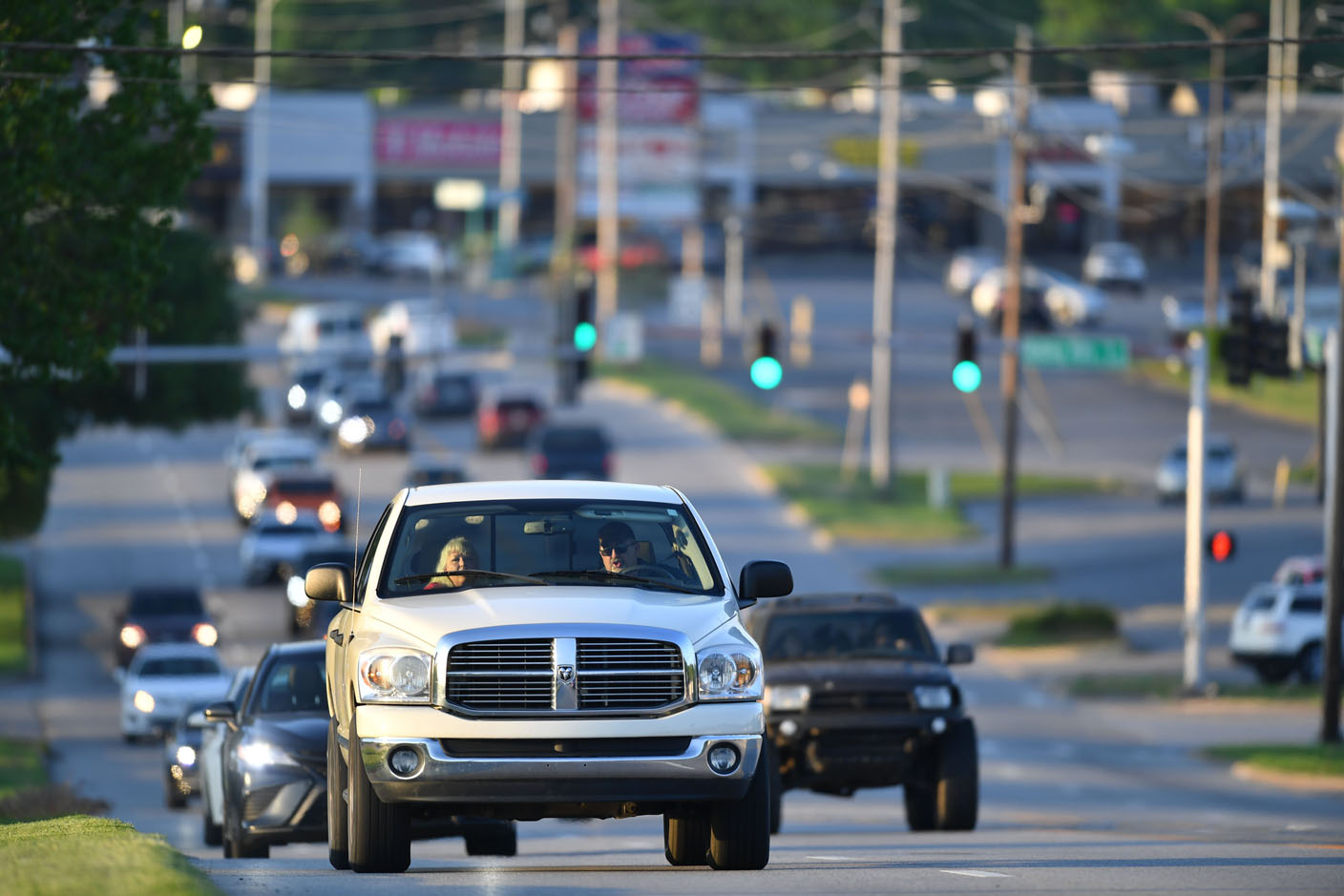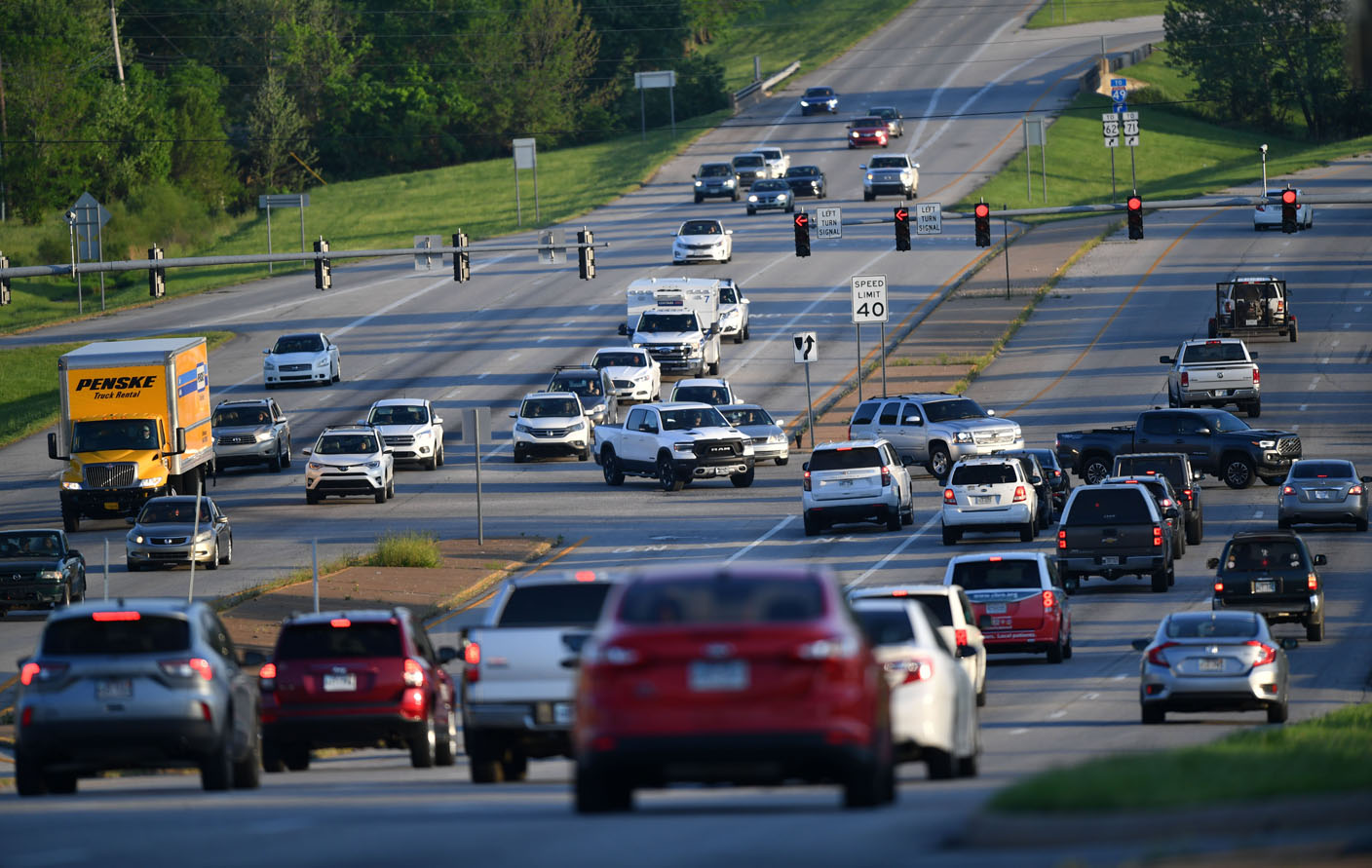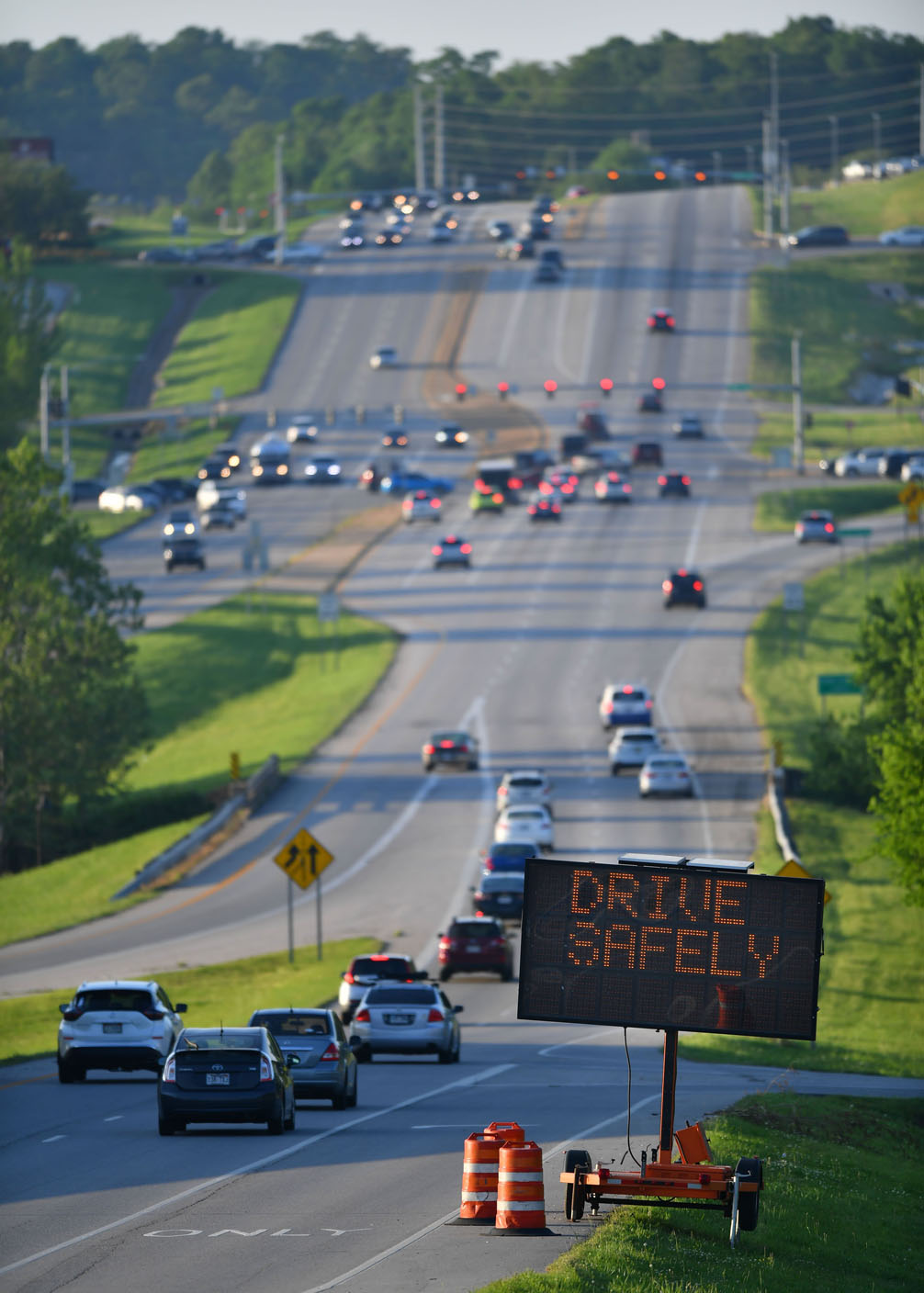Nobody likes sitting in traffic losing time and money, including regional planners who are studying ways to ease congestion on the region's major roadways.
"The study basically analyzes where this congestion is occurring in the region," said Tim Conklin, assistant director of the Northwest Arkansas Regional Planning Commission. "Overall, we still have a lot of work to do in Northwest Arkansas as we continue to forecast significant growth in population over the next 25 years."
Population projections for the region predict about a million people living here by 2045.
"We're really blessed having our population grow over 100,000 people per decade over the last 30 years, but with that comes increased travel demand on our roadways and interstate," he said. "If we were not growing, and the population was declining, and there were fewer people and fewer cars here, it'd be getting better."
Traffic congestion, or gridlock, can cause more than just travel delays making a person late for work or school in the morning and late getting home in the evening. Other problems range from economic losses such as lost time and delays delivering goods to quality of life concerns and even safety.
Gridlock makes it harder to estimate how long it's going to take to reach a destination, results in more fuel being burned, contributes to road rage and slows emergency response times. Sitting in traffic also eats into leisure time and time to do other tasks.
"When a region addresses traffic congestion well, it reduces commuting times and it cuts the cost of transporting goods. It strengthens the region's business environment," said Nelson Peacock, president and CEO of the Northwest Arkansas Council. "Northwest Arkansas must add highways, expand public transit and embrace transportation technology to effectively manage traffic congestion and remain one of the nation's best places."
Congestion management plans are required for areas with populations of more than 200,000, according to the Federal Highway Administration. The plan for Northwest Arkansas was last updated in 2015. The administration defines congestion as an excess of vehicles on a road at a particular time resulting in speeds that are slower -- sometimes much slower -- than normal or free flow speeds.
Out of the 826 miles of road network in the region analyzed in 2019, about 71 miles were identified as congested.
"This year we're updating it, the analysis year however is 2019, due to the pandemic and the impact on people commuting within our region," Conklin said. "So, we have a snapshot in time of 2015 and 2019, and it helps us identify corridors in the region that are the most congested and the region should really focus on."
The region's 2015 congestion management plan identified about 228 miles of congested corridors in the region. A corridor is a generally linear area containing one or more modes of transportation. Many of those have since been addressed with transportation improvement projects, many in cooperation with the Arkansas Department of Transportation.
Improvements to the Arkansas 265 corridor and widening of Interstate 49 and improvement to its interchanges are examples. Those roads are no longer identified as congested corridors in the new study, Conklin said.
Conklin said there are plans for more than $1.5 billion in regional transportation projects over the next 20 years to address growth and the four cities with voter-approved bond projects have over $500 million in work of their own.
"We have studies of the major corridors that have identified projects. It's just going to take additional resources and planning to address our needs in Northwest Arkansas," Conklin said.
The proposed Arkansas 1112 widening and improvements and the 612 Bypass project that is currently being planned and will be constructed over the next five or 10 years are a couple of examples, Conklin said. Another example is Arkansas 265, where the ultimate build-out is for a four lane facility through Rogers.
"We'll update it again in a few years. There's a lot of discussion about are people going to go back to the workplace and what is the new normal," Conklin said. "I think post-covid, we'll see how this all settles out and see how that impacts the transportation system. It's been interesting to see that impact on the transportation system the last couple of years."
Growth in Benton County is significantly impacting the transportation system around Bentonville and Rogers, particularly U.S. 62 and Arkansas 102 and Walton Boulevard, north and south.
In Washington County, significant congestion occurs on U.S. 412 in Springdale and on Martin Luther King Jr. Boulevard and the Wedington Drive/I-49 interchange area in Fayetteville.
Research has shown congestion is typically the result of six root causes often interacting with one another: limited physical capacity, poor traffic signal timing, traffic incidents, work zones, bad weather and special events.
Congestion management identifies areas congested, along with the causes, and then develops and implements solutions. The process includes measuring transportation system performance and reliability and evaluating how effective solutions have been.
An example would be syncing traffic signals across the region. Other strategies could include managing access to highways, adding traffic signals and adding capacity by widening roadways or building roads.
Defining and addressing congestion
Congested corridors are identified by the Federal Highway Administration as those roads which experience the worst (top 15%) congestion during any of four peak periods, including morning and evening rush hours, afternoons and weekends.
"For this study we used a two hour a.m. and p.m. window versus four and the reason for that is obviously in some of the bigger metro areas you have a longer duration of congested conditions," Conklin said. "In Northwest Arkansas, you're typically not having four hour periods of congestion."
Several road projects which could address the congested corridors are identified in the study.
The congestion management process will also draw from a number of existing plans and studies, including the Regional Transportation Plan, Transit Development Plan and the Northwest Arkansas Bike-Ped Plan.
"As we continue to grow, we'll improve our two-lane roads that have no sidewalks and open ditches and narrow lanes and curves with more of a complete street cross section that accommodates all users and modes of transportation," Conklin said.
Complete streets are roads designed to include sidewalks, bike lanes and public transit accommodations.
In addition to streets and highways, planners will look at land-use planning, such as more mixed-use development, infill and greater density and plans to limit sprawl. They'll also look at adding safety measures and including facilities such as bike lanes and dedicated paths to get people moving on bicycles and walking more. Expanded public transit service across the region will also figure significantly in the plan, such as bus rapid transit systems and routes connecting various cities.
Two other plans are in the works to complement the congestion management process by using technology to manage traffic, according to Elizabeth Bowen, a senior planner at Regional Planning. The idea is to modernize traffic signals to improve traffic flow using electronic monitoring and automation to provide real-time traffic and transit management.
Advanced traveler information systems could also be used to provide an extensive amount of data to travelers, such as real-time speed estimates on the web or over wireless devices, and transit vehicle schedule progress.
Traffic control systems, often housed within a traffic management center, could monitor the volume and flow of traffic using a system of sensors and cameras and analyze traffic conditions to spot developing problems. Then the system would make adjustments to traffic signal timing in order to optimize traffic flow.
Equipment could also change posted traffic speed limits approaching areas of congestion, bottlenecks, traffic incidents and other conditions that affect traffic flow.
The cost of sitting in traffic
Nationally, traffic congestion in the U.S. cost drivers more than $53 billion in 2021, a 41% increase from 2020, according to the Inrix 2021 Global Traffic Scorecard, released in December. Inrix specializes in global transportation analytics.
The average American driver lost 36 hours due to congestion-related delays, costing $564 in wasted time. That was a 10 hour increase from 2020, but 63 hours below prepandemic levels.
With many people stuck at home, driving fell significantly, dropping 40% in April 2020, according to Inrix.
Economic costs were calculated based on a report by the Federal Highway Administration which calculated a driver's time is worth $15.60 an hour, according to an Inrix news release. Inrix calculates time loss as the difference between driving during commute hours versus driving at night with little traffic.
"Covid-19's impact on transportation has continued through 2021, transforming when, where and how people move. Although congestion climbed 28% this year, Americans still saved 63 hours compared to normal," said Bob Pishue, transportation analyst at Inrix. "The most notable change to commuting during the pandemic -- other than reduced travel times and volumes -- was the lack of downtown travel."
A 2012 study commissioned by the Northwest Arkansas Council found sitting in traffic was costing Northwest Arkansas residents more than $103 million a year in wasted time and gas. Since that study was done, some improvements have been made to address congestion, but more cars have also been added to the mix because of the region's population growth. The study hasn't been updated.
Eliminating traffic congestion may not be possible, particularly in fast growing regions, the congestion management study concludes. Moreover, eliminating congestion may not actually be desired if it comes at the expense of economic vitality, community livability, or bicycle/pedestrian access. Therefore, it's important to define what is considered "unacceptable congestion" and set appropriate objectives for congestion management that supports regional goals.
 Traffic moves south Thursday, May 12, 2022, on College Avenue in Fayetteville. Regional Planners got their first look last week at a draft of a new traffic congestion management process for the Northwest Arkansas metro area. The study provides a basic assessment of traffic conditions and lays the groundwork for developing strategies to ease congestion on the region?s major roadways. Visit nwaonline.com/220515Daily/ for today's photo gallery. (NWA Democrat-Gazette/Andy Shupe)
Traffic moves south Thursday, May 12, 2022, on College Avenue in Fayetteville. Regional Planners got their first look last week at a draft of a new traffic congestion management process for the Northwest Arkansas metro area. The study provides a basic assessment of traffic conditions and lays the groundwork for developing strategies to ease congestion on the region?s major roadways. Visit nwaonline.com/220515Daily/ for today's photo gallery. (NWA Democrat-Gazette/Andy Shupe) Traffic moves Thursday, May 12, 2022, through the intersection of Joyce Boulevard and College Avenue in Fayetteville. Regional Planners got their first look last week at a draft of a new traffic congestion management process for the Northwest Arkansas metro area. The study provides a basic assessment of traffic conditions and lays the groundwork for developing strategies to ease congestion on the region?s major roadways. Visit nwaonline.com/220515Daily/ for today's photo gallery. (NWA Democrat-Gazette/Andy Shupe)
Traffic moves Thursday, May 12, 2022, through the intersection of Joyce Boulevard and College Avenue in Fayetteville. Regional Planners got their first look last week at a draft of a new traffic congestion management process for the Northwest Arkansas metro area. The study provides a basic assessment of traffic conditions and lays the groundwork for developing strategies to ease congestion on the region?s major roadways. Visit nwaonline.com/220515Daily/ for today's photo gallery. (NWA Democrat-Gazette/Andy Shupe) Traffic moves Thursday, May 12, 2022, along College Avenue in Fayetteville. Regional Planners got their first look last week at a draft of a new traffic congestion management process for the Northwest Arkansas metro area. The study provides a basic assessment of traffic conditions and lays the groundwork for developing strategies to ease congestion on the region?s major roadways. Visit nwaonline.com/220515Daily/ for today's photo gallery. (NWA Democrat-Gazette/Andy Shupe)
Traffic moves Thursday, May 12, 2022, along College Avenue in Fayetteville. Regional Planners got their first look last week at a draft of a new traffic congestion management process for the Northwest Arkansas metro area. The study provides a basic assessment of traffic conditions and lays the groundwork for developing strategies to ease congestion on the region?s major roadways. Visit nwaonline.com/220515Daily/ for today's photo gallery. (NWA Democrat-Gazette/Andy Shupe)More News
NoneMake your voice heard
Planners are working to update the region’s traffic congestion management plan. The draft 2022 Congestion Management Process is open for public comment through Friday . Here’s a link to the draft: https://www.nwarpc.org/transportation/congestion-management-process/
Written comments can be sent to comments@nwarpc.org.
• The Technical Advisory Committee of the Northwest Arkansas Regional Planning Commission will consider the draft Thursday .
• The group’s Policy Committee will consider approval of the draft May 25.
Source: Northwest Arkansas Regional Planning Commission
